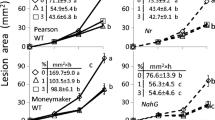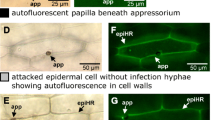Abstract
Two virulent strains ofBotrytis cinerea Pers., one of them (Bc 6) producing abscisic acid (ABA) via 1′,4′-trans-diol-ABA in defined liquid culture, and a second strain (Bc 9) without the ability to form ABA or its fungal precursor, and two near-isogenic lines of tomato were used to study the biosynthesis and metabolism of ABA in infected isolated leaves. The tomato plants used wereLycopersicon esculentum Mill. cv. Ailsa Craig (wild type) and the ABA-deficient mutantflacca. The level of 1′,4′-trans-diol-ABA increased in Ailsa Craig andflacca leaves in a similar pattern to about 4 μg·(gDW)−1 after conidiospore infection with Bc 6, but not after infection with Bc 9. Pulse-feeding experiments showed that [214-C]-1′,4′-trans-diol-ABA was metabolised to ABA and to further plant metabolites of ABA (phaseic acid, dihydrophaseic acid and polar compounds) in both uninfected and infected leaves. Following infection, the turnover of 1′,4′-trans-diol-ABA was reduced. The level of endogenous ABA in leaves infected with the ABA-producing strain Bc 6 rose more than tenfold in Ailsa Craig and twofold inflacca, respectively. Infection of Ailsa Craig leaves with Bc 9 caused a fivefold increase in ABA, and no increase of ABA inflacca. It is concluded that at least four processes control the level of ABA in wild-type tomato leaves infected withBotrytis cinerea: stimulation of fungal ABA biosynthesis by the host; release of ABA or its precursor by the fungus; stimulation of biosynthesis of plant ABA by the fungus; inhibition of its metabolism by the fungus. Application of ABA together with fungal spores to tomato leaves caused a faster development of necrotic leaf area than spore inoculation only.
Similar content being viewed by others
Abbreviations
- ABA:
-
abscisic acid
- t-ABA:
-
2-trans-abscisic acid
- DPA:
-
4′-dihydro abscisic acid
- Me:
-
methylester
- PA:
-
phaseic acid
References
Assante, G., Merlini, L., Nasini, G. (1977) (+)-Abscisic acid, a metabolite of the fungusCercospora rosicola. Experientia33, 1556–1557
Bennett, R.D., Norman, S.M., Maier, V.P. (1981) Biosynthesis of abscisic acid from [1,213-C2] acetate inCercospora rosicola. Phytochemistry20, 2334–2344
Bennett, R.D., Norman, S.M., Maier, V.P. (1984) Biosynthesis of abscisic acid from farnesol derivatives inCercospora rosicola. Phytochemistry23, 1913–1915
Crocoll, C., Kettner, J., Dörffling, K. (1991) Abscisic acid in saprophytic and parasitic species of fungi. Phytochemistry30, 1059–1060
Danneberg, G., Latus, C., Zimmer, W., Hundeshagen, B., Schneider-Poetsch, H., Bothe, H. (1992) Influence of vesicular-arbuscular mycorrhiza on phytohormone balances in maize (Zea mays L.). J. Plant Physiol.141, 33–39
Dörffling, K., Petersen, W., Sprecher, E., Urbasch, I., Hanssen, H.P. (1984) Abscisic acid in phytopathogenic fungi of the generaBotrytis, Ceratocystis, Fusarium, andRhizoctonia. Z. Naturforsch.39, 683–684.
Edwards, H.H. (1983) Effect of kinetin, abscisic acid, and cations on host-parasite relations of barley inoculated withErysiphegraminis f. sp.hordei. Phytopath. Z.107, 22–30
Henfling, J.W.D.M., Bostock, R., Kuc, J. (1980) Effect of abscisic acid on rishitin and lubimin accumulation and resistance toPhytophthora infestans andCladosporium cucumerinum in potato tuber tissue slices. Phytopathology70, 1074–1078
Hewitt, E.J. (1952) Sand and water culture methods used in the study of plant nutrition. Commonwealth Agric. Bureaux, Bucks, UK. Bradley and Sons, Reading
Hirai, N., Okamoto, M., Koshimizu, K. (1985) 1′,4′-trans-diol-ABA, a potent precursor of ABA inBotrytis cinerea. In: 12th Int Conference on Plant Growth Substances, p. 30, Bopp, M., Knoop, B., Rademacher, W., eds. Universität Heidelberg, Germany
Hirai, K., Okamoto, M., Koshimizu, K. (1986) The 1′,4′-trans-diol of abscisic acid, a possible precursor of abscisic acid inBotrytis cinerea. Phytochemistry25, 1865–1868.
Kern, M. (1985) Phytohormongehalte und Assimilattransport in Sommergerstesorten mit unterschiedlicher Resistenz gegenüber dem Echten Mehltau (Erysiphe graminis f. sp.hordei), Ph.D.thesis, Göttingen, Germany
Kettner, J. (1991) Untersuchungen zur Biosynthese von Abscisinsäure bei der Interaktion des pflanzenpathogenen PilzesBotrytis cinerea Pers. mit der KulturtomateLycopersicon esculentum Mill. Ph.D. thesis, Hamburg, Germany
Milborrow, B.V. (1983) The reduction of (+/−)-[214C]abscisic acid to the 1′,4′-trans-diol by pea seedlings and the formation of 4'-desoxy ABA as an artefact. J. Exp. Bot.34, 303–308
Mohanty, S.K., Anjaneyulu, A., Sridhr, R. (1979) Physiology of rice tungro virus disease: Involvement of abscisic acid-like substance in susceptible host-virus interactions. Physiol. Plant.45, 132–136.
Naumann, R., Dörffling, K. (1982) Variations of free and conjugated abscisic acid, phaseic acid and dihydrophaseic acid levels in ripening barley grains. Plant Sci. Lett.27, 111–117
Norman, S.M., Poling, S.M., Maier, V.P., Nelson, M.D. (1985) Ionylidene acetic acids and abscisic acid biosynthesis byCercospora rosicola. Agric. Biol. Chem.49, 2317–2324
Norman, S.M., Bennett, R.D., Poling, S.M., Maier, V.P., Nelson, M.D. (1986) Paclobutrazol inhibits abscisic acid biosynthesis inCercospora rosicola. Plant Physiol.80, 122–125
Okamoto, M., Hirai, N., Koshimizu, K. (1988a) Biosynthesis of abscisic acid. Mem. Coll. Agric., Kyoto Univ.132, 79–115
Okamoto, M., Hirai, N., Koshimizu, K. (1988b) Biosynthesis of abscisic acid inCercospora pini-densiflorae. Phytochemistry27, 2099–2103
Oritani, T., Ichimura, M., Yamashita, K. (1982) The metabolism of analogs of abscisic acid inCercospora cruenta. Agric. Biol. Chem.46, 1959–1960
Parry, A.D., Horgan, R. (1990) Carotenoids and ABA Biosynthesis. News Bull. Br. Soc. Plant Growth Regul.11, 1–9
Parry, A.D., Neill, S.J., Horgan, R. (1988) Xanthoxin levels and metabolism in the wild-type and wilty mutants of tomato. Planta173, 397–404
Pegg, G.F. (1976) Natural growth regulators. In: Encyclopedia of plant physiology, vol. 4: Physiological plant pathology, pp. 560–616, Heitefuss, R., Williams, P.H., eds. Springer-Verlag, Berlin, Heidelberg, New York
Schlenck, M., Gellermann, J.L. (1960) Esterification of fatty acids with diamethane on a small scale. Anal. Chem.32, 1412–1414
Sindhu, R.K., Walton, D.C. (1988) Xanthoxin metabolism in cell-free preparations from wild type and wilty mutants of tomato. Plant Physiol.88, 178–182
Sprecher, E. (1959) Über die Guttation bei Pilzen. Planta53, 565–574
Steadman, J.R., Sequeira, L. (1970) Abscisic acid in tobacco plants.Tentative identification and its relation to stunting induced byPseudomonas solanacearum. Plant Physiol.45, 691–697
Tuomi, T., Ilvesoksa, J., Laakso, S., Rosenquist, H. (1993) Interaction of abscisic acid and indole-3-acetic acid-producing fungi withSalix leaves. J. Plant Growth Regul.12, 149–156.
Vaughan, G.T., Milborrow, B.V. (1984) The resolution by HPLC of RS-[2–14C]-Me-1′,4′-cis-diol of abscisic acid and the metabolism of (−)-R- and (+)-S-abscisic acid. J. Exp. Bot.35, 110–120
Vaughan, G.T., Milborrow, B.V. (1988) The stability of the 1′,4′-diols of abscisic acid. Phytochemistry27, 339–343
Ward, E.W.B., Cahill, D.M., Bhattacharyga, M.K. (1989) Abscisic acid suppression of phenylalanine ammonia-lyase activity and mRNA, and resistance of soybeans toPhytophthora megaspermaf. sp.glycinea. Plant Physiol.91, 23–27
Whenham, R.J., Fraser, R.S.S. (1981) Effect of systemic and local-lesion-forming strains of tobacco mosaic virus on abscisic acid concentration in tobacco leaves: consequences for the control of leaf growth. Physiol. Plant Pathol.18, 267–278
Whenham, R.J., Fraser, R.S.S., Snow, A. (1985) Tobacco mosaic virus induced increase in abscisic acid concentration in tobacco leaves: intracellular location and relationship to symptom severity and to extent of virus multiplication. Physiol. Plant Pathol.26, 379–387
Whenham, R.J., Fraser, R.S.S., Brown, L.P., Payne, J.A. (1986) Tobacco mosaic virus-induced increase in abscisic acid concentration in tobacco leaves: Intracellular location in light and darkgreen areas, and relationship to symptom development. Planta168, 592–598
Author information
Authors and Affiliations
Additional information
We thank Dr. Clive Cain (Glaxo GmbH, Hamburg, Germany) for his careful review of the manuscript, Dr. Irene Urbasch and Prof. Dr. Ewald Sprecher (University of Hamburg, Germany) for helpful suggestions and for providing the strains of Botrytis cinerea. This work was supported by the Deutsche Forschungsgemeinschaft.
Rights and permissions
About this article
Cite this article
Kettner, J., Dörffling, K. Biosynthesis and metabolism of abscisic acid in tomato leaves infected withBotrytis cinerea . Planta 196, 627–634 (1995). https://doi.org/10.1007/BF01106753
Received:
Accepted:
Issue Date:
DOI: https://doi.org/10.1007/BF01106753




